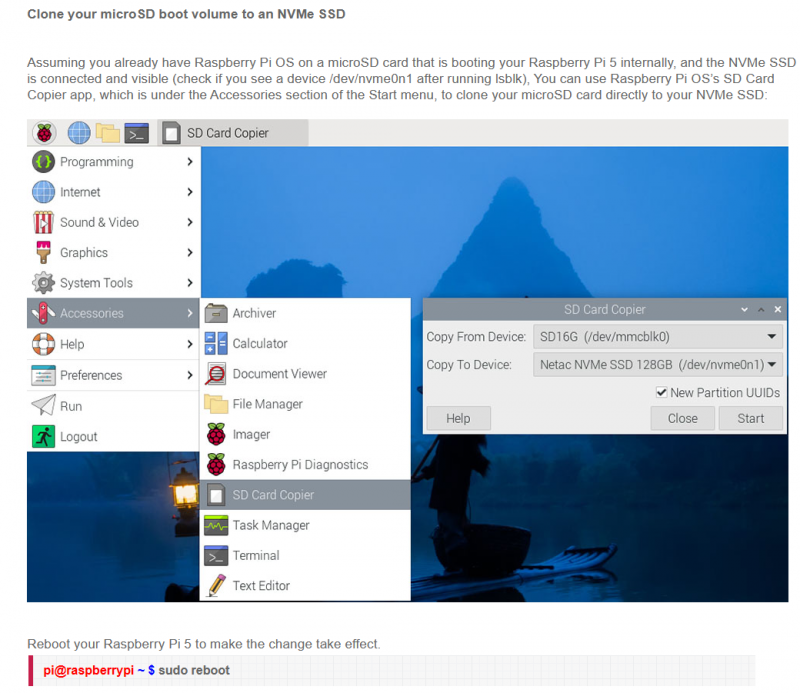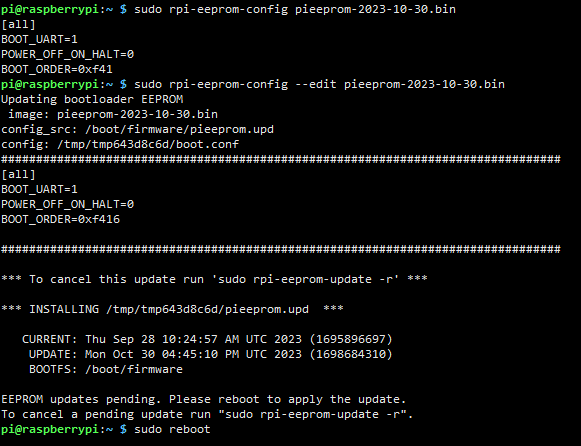NVMe SSD boot with the Raspberry Pi 5
Most of the content of this tutorial comes from Jeff's blog: NVMe SSD boot with the Raspberry Pi 5, Thanks fo Jeff
Contents
Enable PCIe
By default the PCIe connector is not enabled. To enable it you should add the following option into /boot/firmware/config.txt and reboot:
sudo nano /boot/config.txt
Then add the following comment;
# Enable the PCIe External connector. dtparam=pciex1 # This line is an alias for above (you can use either/or to enable the port). dtparam=nvme
Press Ctrl-O, then enter, to write the change to the file.
Press Ctrl-X to exit nano (the editor).
And the connection is certified for Gen 2.0 speed (5 GT/sec), but you can force it to Gen 3.0 (10 GT/sec) if you add the following line after:
dtparam=pciex1_gen=3
However, we DON'T recommend you to use Gen 3.0 as it is not officially supported and may not work stably.
Then DON'T forgot to reboot
sudo reboot
You also can refer to official documentatio:Enabling PCIe
Flash OS onto NVME SSD
To get the NVMe SSD to boot your Pi, it needs to have an OS, so the Raspberry Pi OS needs to be flashed onto NVME SSDs, this is very important!
Only support Raspberry Pi OS (Bookworm) version, Raspberry Pi OS bullseye is NOT supported, rfer to https://www.raspberrypi.com/software/operating-systems/
Here are a few ways to flash the OS to an NVME SSD:
1. Use SD Card Copier tool to flash OS onto the NVME SSD On Raspberry Pi OS(recommended)
- This method works if you have an SD card and have booted the device successfully
Cick Applications =>Accessories =>SD Card Copier on the main screen, run the SD Card Copier program, and copy the OS to the NVME ssd as shown in the figure below.
Click Start to run. Then shut down, unplug the SD card, and restart the device.
This is a visual operation and we highly recommend it!
2. Flash the SSD with Raspberry Pi Imager
You can also directly use the Raspberry Pi Imager tool on a MAC computer or windows computer to flash a fresh Pi OS to NVME SSD, but you will need an additional USB to nvme adapter.
- Install Pi Imager and open it
- Plug your NVMe SSD into your computer using a USB to NVMe adapter
- Choose an OS to install
- Choose the drive (connected through your adapter) to flash
- Click write (and set any options you'd like)
Once flashing is complete, pull the NVMe drive, attach it to your Pi 5, and it should boot off it (with or without a microSD card inserted)—assuming you have the bootloader up to date and set the BOOT_ORDER appropriately!
NOTE:
If you are flashing a fresh Pi OS to NVME ssd, you must #Enable PCIe; if you are COPY or CLONE an old Pi OS from SD card to NVME ssd, and you have already enabled pcie in the old Pi OS in advance, then you don't need to do enable pcie again!
Set NVMe early in the boot order
The PCIe connection should work after a reboot, but your Pi won't try booting off an NVMe SSD yet. For that, you need to change the BOOT_ORDER in the Raspberry Pi's bootloader configuration:
Run the following command to edit the EEPROM on the Raspberry Pi 5.
sudo rpi-eeprom-config --edit
Then change the BOOT_ORDER line to the following:
BOOT_ORDER=0xf416
- Press Ctrl-O, then enter, to write the change to the file.
- Press Ctrl-X to exit nano (the editor).
Read Raspberry Pi's documentation on BOOT_ORDER for all the details. For now, the pertinent bit is the 6 at the end: that is what tells the Pi to attempt NVMe boot first!
Reboot your Raspberry Pi 5 to make the change take effect.
How to update eeprom firmware
NOTE: If you find that there is no WIFI or ssd is not recognized after restarting, you can try this part of the update, otherwise please ignore it.
After modifying the BOOT_ORDER for NVME SSD, reboot the PI5 and you maybe get the NO WIFI or other error. Try to upgrade the eeprom to fix it (Raspberry Pi Foundation official may upgrade the OS to solve this kind of problem, please pay attention to the update of Raspberry Pi OS, if the OS upgrade can solve this problem, you can ignore this step).
Run the following command to
wget https://github.com/timg236/rpi-eeprom/raw/pieeprom-2023-10-30-2712/firmware-2712/default/pieeprom-2023-10-30.bin sudo rpi-eeprom-config --edit pieeprom-2023-10-30.bin
It is recommended to use the latest version of the pieeprom-xxxx-xx-xx.bin file, please visit this link to get the latest version:
PS: After our testing, we found that only the firmware piepprom-2023-10-30.bin has solved the NO WIFI problem for the time being.
FAQ
Q: Can't boot/recognize from NVMe SSD?
A: Here are a few steps to help you troubleshoot some issues:
- Make sure all hardware connections are properly connected and coupled.
- Only Raspberry Pi OS (Bookworm) supports PCIe, Raspberry Pi OS bullseye is NOT supported, refer to https://www.raspberrypi.com/software/operating-systems/
- Although you can also boot from a SD card, Pi OS is required for the NVMe SSD to boot, DON'T forget Flash OS onto NVMe SSD.
- If you're flashing a fresh Pi OS , DON'T forget to ENABLE PCIe.
- Run the lspci or lsblk command to check the NVMe SSD is recognized.
- Update the firmware, refer to #How to update eeprom firmware
- Contact us at email: support@geekworm.com
- Refer to the issue solved by customer: https://geekworm.com/community/forum/topic/120764/geekworm-x1001-for-raspberry-pi-5


Enable comment auto-refresher
Anonymous user #11
Permalink |
Anonymous user #8
Permalink |
Anonymous user #6
Permalink |
Anonymous user #9
Anonymous user #10
Anonymous user #5
Permalink |
Anonymous user #7
Anonymous user #4
Permalink |
Anonymous user #4
Anonymous user #3
Permalink |
Anonymous user #2
Permalink |
Harry
Anonymous user #1
Permalink |
Walker